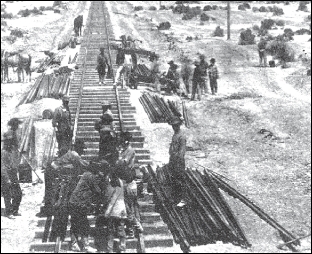 | ||
Transformation of Paradise ValleyMark Twain once said that if you want to know what actually happened during the past, read the information provided by someone who was there when the event occurred. His conclusion was that someone writing history from the perspective of looking back, doesn't always provide the most interesting details of what actually happened - at least not as interesting as someone who had first knowledge of an event. While Sol P. Elias did not live through the events of the founding of Modesto, among regional historians, he was one who was close to many events that occurred and decided to publish his book of memories and stories, "Stories of Stanislaus," in 1924. What follows is quoted directly from a 1924 copy of the book, given to Lucile Hooper in 1934, ("pretty girl with the compliments of the author."): "The years 1870-71 were important in the economic and in the political history of Stanislaus county. They witnessed the obliteration of settlements that had been landmarks since the county's creation, and the birth of cities that were destined to assume leadership in politics and in agricultural industry. They beheld the advent of the steel highway through Paradise Valley, its appearance in the eastern end of the county, the passing of water traffic on the Tuolumne river, and the disappearance of the teaming over the plains of produce to the markets. They observed the transfer of the seat of government from the county's extreme east to its center. They saw the beginnings of an era of progress in this central area - a few years previously regarded as a desert and unfit for agriculture. "The remarkable fertility of the virgin soil of Paradise Valley, its marvelous cereal production, and its rapid settlement caused the builders of rail roads to look to the San Joaquin Valley. Having built as far south as Lathrop, the fact was recognized early in 1870 that the Central Pacific would attempt to tap this great valley with its potential possibilities in development." Elias also comments on the fact that the railroad had a difficult time penetrating "the broad acres of Paradise Valley in 1870." "Strangely enough the political sentiment of the majority of the people of the county at this early day was strongly anti-railroad. Surveys were made through Paradise, Ripperdan, Empire and through the center of the county. The most logical route was determined to be through Paradise. The railroad authorities desired from the citizens of this settlement, a right of way through the river at this point. After negotiations the people of Paradise refused to grant the railroad any concessions." Tinkham's history quotes from the Tuolumne City News about the exodus from existing towns to the new village of Modesto: "When it became generally known where the new town was to be located, there was a general stampede from the three towns of Empire, Tuolumne and Paradise to the new site. For months the highways were thronged with buildings being moved to Modesto and it looked as though Tuolumne and Paradise were on wheels." |
Building a Railroad. c.1870. The railroad under construction in the San Joaquin Valley shows the barren landscape and the work involved laying the steel highway. This Southern Pacific Railroad image was published in the Stanislaus Historical Quarterly. After negotiations the people of Paradise refused to grant the railroad any concessions. . . the Central Pacific Railroad Company then purchased the present site of Modesto . . . Before the end of the year Modesto came into existence and Paradise, Tuolumne City, Berryville and Empire became memories of the county's infancy. -- "Stories of Stanislaus"
|

